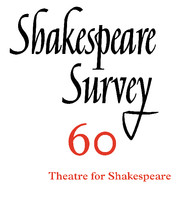Book contents
- Frontmatter
- Professional Players in the Guild Hall, Stratford-upon-Avon, 1568–1597
- Reconstructing The Rose: Development of the Playhouse Building between 1587 and 1592
- The Rose and its Stages
- Philip Henslowe and the Elizabethan Court
- From Revels to Revelation: Shakespeare and the Mask
- Bride-ing the Shrew: Costumes that Matter
- ‘When Men and Women are Alone’: Framing the Taming in India
- The Crown and the Pillow: Royal Properties in Henry IV
- Humanity at Stake: Man and Animal in Shakespeare’s Theatre
- Popular Shakespeare in Japan
- ‘Philosophy in a Gorilla Suit’: Do Shakespearians Perform or Just Perform-a-tive?
- Sudokothellophobia: Writing Hypertextually, Performatively
- Living Monuments: The Spatial Politics of Shakespeare’s Rome on the Contemporary Stage
- ‘In Windsor Forest and at the Boar’s Head’: The ‘Falstaff Plays’ and English Music in the Early Twentieth Century
- Michael Bogdanov in Conversation
- The Mouse and the Urn: Re-Visions of Shakespeare from Voltaire to Ducis
- ‘I covet your skull’: Death and Desire in Hamlet
- Martin Droeshout Redivivus: Reassessing the Folio Engraving of Shakespeare
- Canonizing Shakespeare: The Passionate Pilgrim, England’s Helicon and the Question of Authenticity
- Rereading Shakespeare: The Example of Richard Brathwait
- Shakespeare Performances in England, 2006: January 2006
- Professional Shakespeare Productions in the British Isles January–December 2005
- he Year's Contributions to Shakespearian Study 1 Critical Studies
- 2 Shakespeare in Performance
- 3 Editions and Textual Studies
- Index
Philip Henslowe and the Elizabethan Court
Published online by Cambridge University Press: 28 November 2007
- Frontmatter
- Professional Players in the Guild Hall, Stratford-upon-Avon, 1568–1597
- Reconstructing The Rose: Development of the Playhouse Building between 1587 and 1592
- The Rose and its Stages
- Philip Henslowe and the Elizabethan Court
- From Revels to Revelation: Shakespeare and the Mask
- Bride-ing the Shrew: Costumes that Matter
- ‘When Men and Women are Alone’: Framing the Taming in India
- The Crown and the Pillow: Royal Properties in Henry IV
- Humanity at Stake: Man and Animal in Shakespeare’s Theatre
- Popular Shakespeare in Japan
- ‘Philosophy in a Gorilla Suit’: Do Shakespearians Perform or Just Perform-a-tive?
- Sudokothellophobia: Writing Hypertextually, Performatively
- Living Monuments: The Spatial Politics of Shakespeare’s Rome on the Contemporary Stage
- ‘In Windsor Forest and at the Boar’s Head’: The ‘Falstaff Plays’ and English Music in the Early Twentieth Century
- Michael Bogdanov in Conversation
- The Mouse and the Urn: Re-Visions of Shakespeare from Voltaire to Ducis
- ‘I covet your skull’: Death and Desire in Hamlet
- Martin Droeshout Redivivus: Reassessing the Folio Engraving of Shakespeare
- Canonizing Shakespeare: The Passionate Pilgrim, England’s Helicon and the Question of Authenticity
- Rereading Shakespeare: The Example of Richard Brathwait
- Shakespeare Performances in England, 2006: January 2006
- Professional Shakespeare Productions in the British Isles January–December 2005
- he Year's Contributions to Shakespearian Study 1 Critical Studies
- 2 Shakespeare in Performance
- 3 Editions and Textual Studies
- Index
Summary
At the opening of the well-known film Shakespeare in Love (1998) we are told that in 1593 ‘two [London] theatres were fighting it out for playwrights and audiences’. One of these was the Rose Playhouse, located on Bankside, south of the River Thames, a theatre owned by a dyer named Philip Henslowe. Tom Stoppard, who wrote the screenplay for Shakespeare in Love, described Henslowe as ‘a man with a cash flow problem’; and Geoffrey Rush, who portrayed him in the film, depicted the theatre owner as a naive but lucky buffoon. As viewers of Shakespeare in Love are informed, Henslowe knows little about theatrical performance and even less about playwriting. In his words a good play is one that includes ‘mistaken identities, a shipwreck, a pirate king, a bit with a dog, and love triumphant’.
Philip Henslowe similarly, if more sympathetically – as a theatre manager whose primary interest was hearing the sound of pennies jingling in the collection box. Consequently, for some time now Henslowe has been identified as a ‘banker’, an ‘entrepreneur’, or simply a ‘financier’, impressions that grow naturally out of the extant evidence that has come down to us – most of it consisting of financial papers relating to Henslowe’s businesses. Of course, the terms by which Henslowe has been commonly identified are not, in themselves, mutually exclusive. Each characterizes some part of his life. However, the very list of terms – ranging from ‘manager’ to ‘impresario’ – points up our uncertainty about Henslowe’s position vis-à-vis the playhouses he owned and the playing companies that occupied them. But as it turns out, even such a lengthy list of terms is insufficient to suggest the many complexities of Philip Henslowe’s life, or to explain how some of the seemingly disparate elements within his life actually complement one another.
- Type
- Chapter
- Information
- Shakespeare Survey , pp. 49 - 57Publisher: Cambridge University PressPrint publication year: 2007

